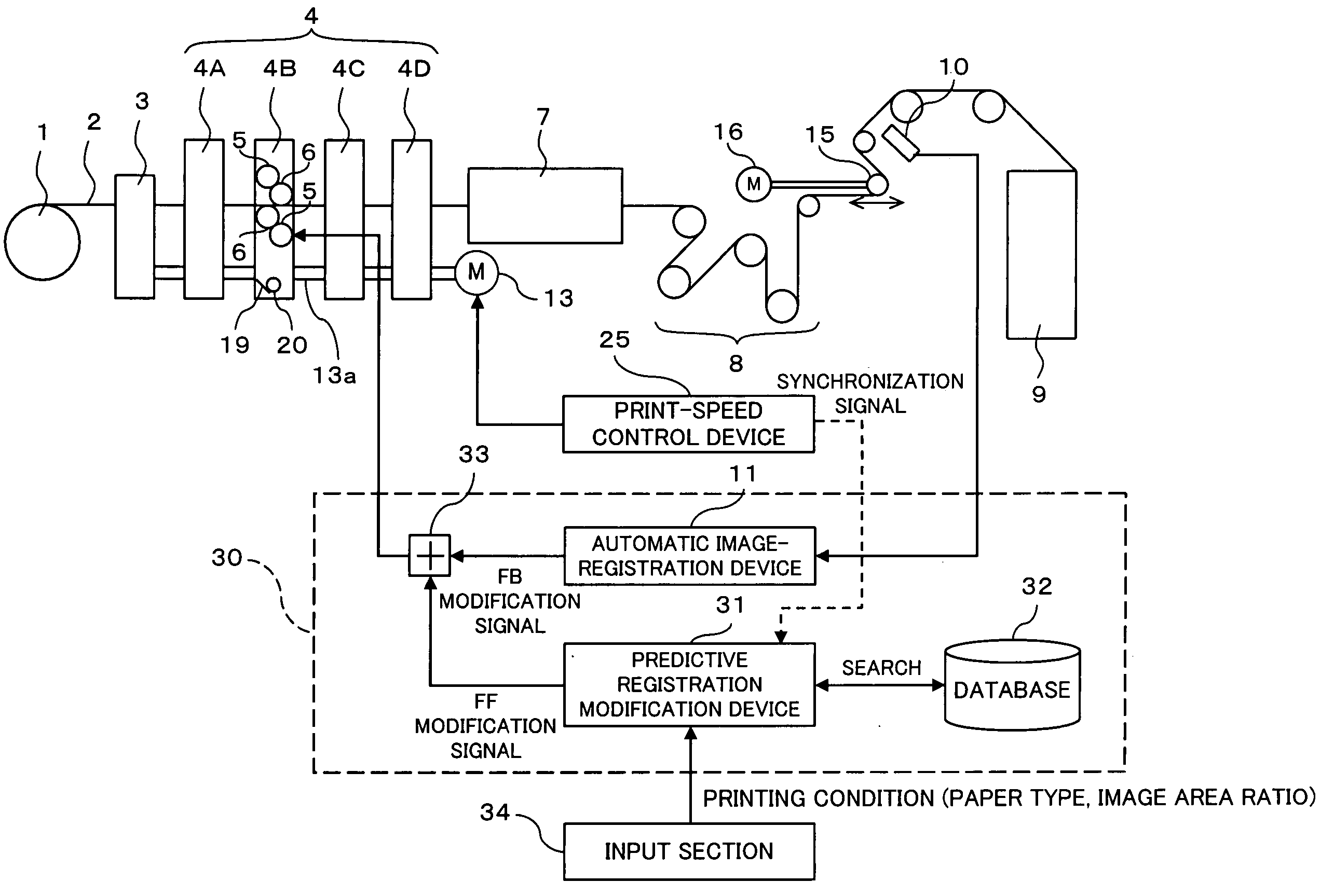Misregistration when printing speed is changed, cutting misregistration, or pinter in which variation of printing density can be controlled
a printing machine and printing speed technology, applied in printing presses, rotary letterpress machines, printing presses, etc., can solve the problems of affecting the efficiency of rotary printing machines, and unable to keep up with the dispersion, so as to prevent the occurrence of broken, the effect of suppressing the fluctuation of cut registration
- Summary
- Abstract
- Description
- Claims
- Application Information
AI Technical Summary
Benefits of technology
Problems solved by technology
Method used
Image
Examples
first embodiment
(A) First Embodiment
[0086]FIG. 1 is a schematic diagram showing the arrangement of a rotary printing machine according to the first embodiment of the present invention. As shown in FIG. 1, the rotary printing machine according to the present embodiment differs from the conventional rotary printing machine shown in FIG. 16 only in arrangement of the control device, being identical in arrangement of the main body of the printing machine. It is to be noted, however, that FIG. 1 is strictly for the purpose of simplifying the explanation of the nonessential part of the present invention, and does not signify that the registration control method according to the present invention is limitedly applied to the rotary printing machines with such arrangement.
[0087] The rotary printing machine according to the present embodiment has a predictive registration modification device 31 in addition to the conventional automatic image-registration device (automatic registration modification means) 11...
second embodiment
(B) Second Embodiment
[0104]FIG. 6 is a schematic diagram showing the arrangement of a rotary printing machine according to the second embodiment of the present invention. As shown in FIG. 6, the rotary printing machine according to the present embodiment differs from the conventional rotary printing machine shown in FIG. 18 only in arrangement of the control device, being identical in arrangement of the main body of the printing machine. It is to be noted, however, that FIG. 6 is strictly for the purpose of simplifying the explanation of the nonessential part of the present invention, and does not signify that the registration control method according to the present invention is limitedly applied to the rotary printing machines with such arrangement.
[0105] The rotary printing machine according to the present embodiment has a predictive registration modification device (predictive cut-registration modification means) 41 in addition to the conventional automatic cut-registration devi...
third embodiment
(C) Third Embodiment
[0124]FIG. 10 is a schematic diagram showing the arrangement of a rotary printing machine according to the third embodiment of the present invention. As shown in FIG. 10, the rotary printing machine according to the present embodiment differs from the conventional rotary printing machine shown in FIG. 20 only in arrangement of the control device, being identical in arrangement of the main body of the printing machine. It is to be noted, however, that FIG. 10 is strictly for the purpose of simplifying the explanation of the nonessential part of the present invention, and does not signify that the print density control method according to the present invention is limitedly applied to the rotary printing machines with such arrangement. In FIG. 10, like components as in the conventional printing machine are designated by the same reference numerals.
[0125] The ink supply control device 50 of the rotary printing machine according to the present embodiment has a new sp...
PUM
 Login to View More
Login to View More Abstract
Description
Claims
Application Information
 Login to View More
Login to View More - R&D
- Intellectual Property
- Life Sciences
- Materials
- Tech Scout
- Unparalleled Data Quality
- Higher Quality Content
- 60% Fewer Hallucinations
Browse by: Latest US Patents, China's latest patents, Technical Efficacy Thesaurus, Application Domain, Technology Topic, Popular Technical Reports.
© 2025 PatSnap. All rights reserved.Legal|Privacy policy|Modern Slavery Act Transparency Statement|Sitemap|About US| Contact US: help@patsnap.com



